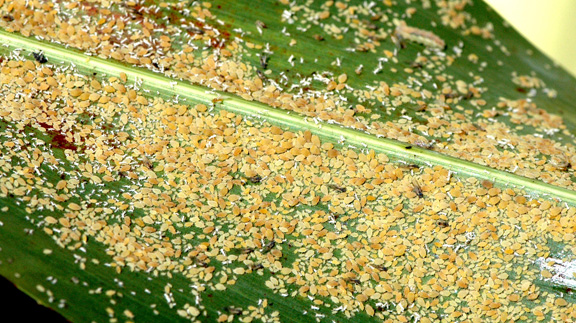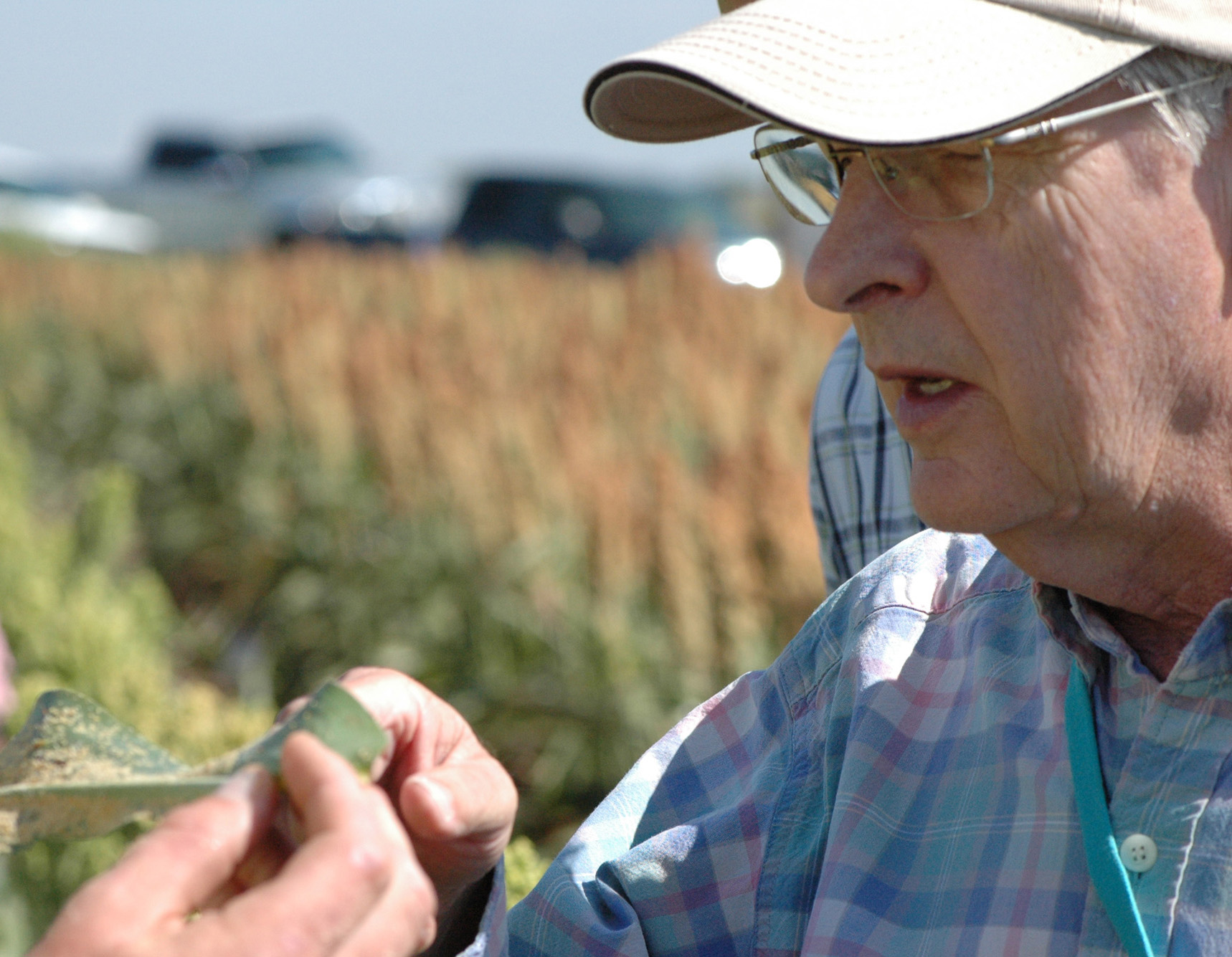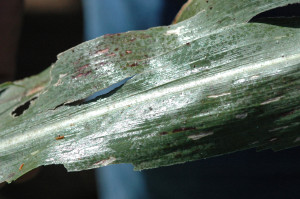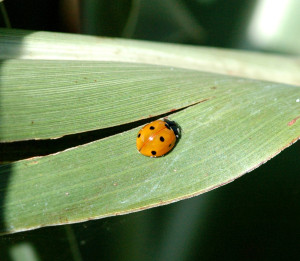Farm & Ranch
[AgriLife Today] AgriLife Extension offers management options for sugarcane aphids in the High Plains

By: Kay Ledbetter
Writer: Kay Ledbetter, 806-677-5608, [email protected]
Contact: Dr. Ed Bynum, 806-677-5600, [email protected]
AMARILLO – Texas A&M AgriLife Extension Service entomologists are trying to help producers prepare for the likelihood of the sugarcane aphid on the Texas High Plains in 2016.

Dr. Ed Bynum, Texas A&M AgriLife Extension Service entomologist in Amarillo, looks at sugarcane aphids covering a leaf during a 2015 sorghum field day. (Texas A&M AgriLife Communications photo by Kay Ledbetter)
The first step will be to make sure all producers are able to identify the sugarcane aphid and know the difference between other insects out there that look very similar, such as the greenbug, Bynum said. The sugarcane aphid has dark cornicles, tips of antennae and feet, and no stripe down its back; the greenbug doesn’t.
He said all sugarcane aphids are females. They live an average of 28 days, are born pregnant and have a live birth. The new aphids only take four to 12 days before they become an adult and can start giving birth to one to three offspring a day.

Sugarcane aphids feeding on a sorghum leaf left a shiny sticky honeydew behind and a black sooty mold is beginning to show. (Texas A&M AgriLife Communications photo by Kay Ledbetter)
Their damage is caused by the piercing sucking mouthparts, Bynum said. This action puts the plant in poor health and can keep it from fully developing. Excess plant sap during feeding is bypassed out on to the leaves as a sticky substance called honeydew. A black sooty mold will grow on the honeydew causing a reduction of photosynthesis.
Excessive feeding can cause significant yield loss and weakens the stalk, predisposing it to lodging, he said.
Persistent populations can exist on sorghum, johnsongrass, Sudan grass, pearl millet and broomcorn. Non-persistent populations can be found on sugarcane, corn, large crabgrass, barnyard grass, Japanese millet, napier grass. It does not establish on wheat, oats and rye.
Bynum said arrival time of the insect determines the risk. If the sugarcane aphids show up in the pre-boot stage of the crop, 81-100 percent yield loss can be expected if not treated. If the arrival occurs at the boot stage, the potential yield loss could be 52-69 percent; at panicle emergence, 67 percent; and at soft dough stage, 21 percent.

Sugarcane aphids can multiply rapidly if sorghum fields are left untreated. (Texas A&M AgriLife Communications photo by Kay Ledbetter)
It is still uncertain whether sugarcane aphids overwinter in the southern High Plains, so AgriLife Extension has nine overwintering monitoring sites set up from Dalhart down to San Angelo. He said they will begin checking the cages in April in both the South Plains and the Panhandle. If no aphids are found, the cages will be checked again in May and June.
Bynum said in field trials at Lubbock last season, there was a 74 percent yield loss between treated and untreated sorghum at the boot stage.
“If you start seeing physical damage to the field or crop canopy, you have a heavy infestation already,” he said.
The options to avoid damage are: plant outside the normal planting window; use insecticide seed treatments; plant resistant hybrids and determine when to treat.
“If you plant early, the field could be in later growth stages when aphids arrive, which would have less risk of being severely damaged,” Bynum said.

Lady beetles are one of the beneficial insects that feed on sugarcane aphids. (Texas A&M AgriLife Communications photo by Kay Ledbetter)
The early planted sorghum may reach the boot or flowering stage before a mid-June aphid arrival, while standard planted sorghum would be in the whorl to pre-boot stage, he said. An August to September aphid arrival would allow early planted sorghum to escape damage until grain filling, while a standard planting would have the crop in the boot to flowering stage. Late-planted sorghum would be in the whorl stage.
The later the infestation, he said, the more beneficial insects might be out, lessening the need for chemical control. Also, the aphid reproduction may slow with shorter days and cooler nights.

Lady beetle eggs found on the same leaves as sugarcane aphids can indicate there will be beneficial insect control. (Texas A&M AgriLife Communications photo by Kay Ledbetter)
“Our best recommendation is to plant early,” Bynum said. “Use insecticide seed treatments on all sorghum, regardless of planting date. And then be ready to treat if needed.”
He said there are some commercial hybrids that have shown to be less susceptible to the sugarcane aphid than other hybrids, but this level of resistance may not prevent aphids from causing yield losses.
So producers need to monitor and treat just like susceptible hybrids. However, Bynum said if the resistant or tolerant hybrid is a good yielding hybrid and fits in the farming operations, then it could provide enough protection to prevent significant yield loss and reduce the number of insecticide applications compared to a susceptible hybrid.
“We have not been able to evaluate the tolerant or resistant hybrids being sold to know just what level of protection they provide,” he said. “So, contact your seed dealer to find out which of these hybrids they recommend for the highest yield potential.”
The revised threshold for the Texas High Plains is to treat when: 20 percent of plants have aphids in the pre-boot stage; 20 percent of the plants have no more than 50 aphids in the boot stage; and 30 percent in the flowering, soft dough and dough stages, Bynum said.
“Look for small colonies and patches of honeydew,” he said. “It’s a numbers game. If you have five aphids one day, by the time you can schedule a sprayer in a week, you have 250. Act quickly.”
Producers should check for reinfestation after four to seven days, Bynum said.
“If you only kill 90 percent with the first treatment, they will start building back up on you quickly,” he said. “We recommend you scout at least two times per week because of how fast they can build back up.”
“At black layer, you don’t want them moving into the head and causing honeydew and harvest problems,” Bynum said.
Currently Sivanto is the only effective labeled insecticide that is safe for beneficial insects, he said. The label for Transform, also effective, was cancelled by the Environmental Protection Agency. The Texas Department of Agriculture has submitted a request to get a Section 18 for its use in treating sugarcane aphid and provide producers with another option.
Predator and parasite numbers may not be able to initially prevent damaging sugarcane aphid buildup, but they could prevent the need for a second application, Bynum said.
-30-
Farm & Ranch
Ag Elsewhere: Wyoming

By Tressa Lawrence
Babies are tucked away in every nook and cranny. Many ranchers across Wyoming have baby animals popping up all over this time of year.
Farm & Ranch
Ag Elsewhere: Montana

By Lindsey Monk
Another load of grain in to keep feeding the calves until the green grass can really start popping.
Farm & Ranch
Meanwhile, Back at the Ranch….

By Rayford Pullen | [email protected]
Spring has sprung and hopefully the rains will continue where our country will heal from the previous droughts and our grasses will thrive. We are especially hopeful for the Panhandle of Texas where our neighbors and friends have been dealt a deadly blow to homes, ranges, livestock, and people. Keep them in your prayers as they will not be able to return to normal for many years if at all. Having lost their ability to benefit from this great cattle market is a double whammy for all of them.
Now is the time of year when we need to take care of business as it relates to our new calves that have been hitting the ground this spring. First and foremost is vaccinating for Blackleg followed by deworming with a white wormer and the IBR complex. Blackleg is a soil-born disease and with pastures extremely short this spring our calves have been grazing the green grass as soon as it shows itself, making them even more vulnerable to picking contaminates from the soil.
To read more, pick up a copy of the April issue of NTFR magazine. To subscribe by mail, call 940-872-5922.
-

 Country Lifestyles1 year ago
Country Lifestyles1 year agoScott & Stacey Schumacher: A Growth Mindset
-

 Equine7 months ago
Equine7 months agoThe Will to Win
-

 Country Lifestyles7 years ago
Country Lifestyles7 years agoStyle Your Profile – What your style cowboy hat says about you and new trends in 2017
-

 Country Lifestyles4 years ago
Country Lifestyles4 years agoAmber Crawford, Breakaway Roper
-

 HOME7 years ago
HOME7 years agoGrazing North Texas – Wilman Lovegrass
-

 Country Lifestyles7 years ago
Country Lifestyles7 years agoDecember 2016 Profile, Rusty Riddle – The Riddle Way
-

 Country Lifestyles8 years ago
Country Lifestyles8 years agoJune 2016 Profile – The man behind the mic: Bob Tallman
-

 Country Lifestyles8 years ago
Country Lifestyles8 years agoCowboy Culture with Clay Reid – Being a Man






